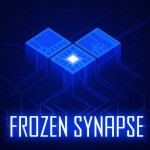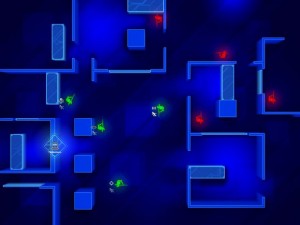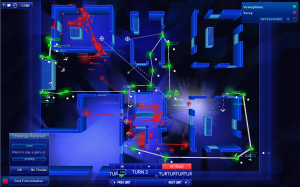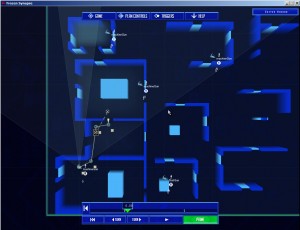 It’s a sign of the strength of the indie games scene that the buzz surrounding a seemingly niche title can rival those of major releases by mainstream publishers. For every big release that slips under the radar (Singularity, Ico) there is a corresponding tiny team of hard working indie devs that make something so exciting and original that the gaming press latches on to it (Sword and Sworcery, Minecraft). So it is with Frozen Synapse, a game that leaked out gradually through betas and early releases, garnering critical praise and building a fanbase steadily along the way.
It’s a sign of the strength of the indie games scene that the buzz surrounding a seemingly niche title can rival those of major releases by mainstream publishers. For every big release that slips under the radar (Singularity, Ico) there is a corresponding tiny team of hard working indie devs that make something so exciting and original that the gaming press latches on to it (Sword and Sworcery, Minecraft). So it is with Frozen Synapse, a game that leaked out gradually through betas and early releases, garnering critical praise and building a fanbase steadily along the way.
I was first exposed to Mode 7’s unique simultaneous turn based strategy game long before its official release as a beta, and even back then it was clear that it was very different from everything else available at the time. Even today, a few months after its official release, there’s nothing else that plays quite the same. The closest analogy would be the planning phase of the old Rainbow Six games, interspersed with the kind of strategy and tactics involved in the UFO or X-Com games. Those are loose comparisons though, the only way to really understand the systems in place in the game are to sit and play it.
 Play is split into two sections, the planning phase and the action. During planning, you set a series of waypoints for your digital soldiers from a top down map. Laying down these waypoints is simple enough, but the most important consideration is generally making sure their firing arc is facing any enemies they may stumble across as they move. Complexity arises from the adding special commands to waypoints, such as having the soldiers pause for a set amount of time, duck down behind cover, move quickly without engaging any enemies they observe or change the way they face. Each planning phase therefore is a subtle guessing game of anticipating the moves the opponents will make and setting your own troops up to move towards their opponents while always facing them and maintaining better combat positions. When troops do meet the victor is determined by how little they have moved, their cover, their facing and the weapon they possess.
Play is split into two sections, the planning phase and the action. During planning, you set a series of waypoints for your digital soldiers from a top down map. Laying down these waypoints is simple enough, but the most important consideration is generally making sure their firing arc is facing any enemies they may stumble across as they move. Complexity arises from the adding special commands to waypoints, such as having the soldiers pause for a set amount of time, duck down behind cover, move quickly without engaging any enemies they observe or change the way they face. Each planning phase therefore is a subtle guessing game of anticipating the moves the opponents will make and setting your own troops up to move towards their opponents while always facing them and maintaining better combat positions. When troops do meet the victor is determined by how little they have moved, their cover, their facing and the weapon they possess.
If each soldier was armed identically the game would still be strategically deep, but with shotguns, machine guns and sniper rifles all having different optimal uses, the planning phase can be a head-scratching but engrossing experience. With wall bouncing grenades and lethal missile launchers adding to the spectacle and destroying the level geometry the scene is set for brutally complex plans to be devised, revised, abandoned and revisited. To a casual observing third party it must seem like almost nothing is actually happening, but to the individual playing the game the action is playing out in their mind like a scene from a Jet Li movie, where the two combatants are able to anticipate every move the other will make and thus can determine a winner without ever actually fighting.
 When the planning phase ends and the combat begins its short and unbelievably brutal. Everyone moves at once and its almost impossible to take in everything that happens in a single turn. Luckily, the action can be played back again as a replay by clicking a single button. One drawback is that I was never able to find a way to watch the playback of the round at a slower speed which would have helped make it easier to take in everything that happened. Still, by looking at small parts of the action in isolation and playing back the action its clear to see what parts of your plan worked and where you went wrong. Particularly in the small skirmish matches, the whole game can be settled very quickly; sometimes even the first round will be enough to determine a winner and loser. One you know how quickly the winner can be determined the desire to hit the action button is replaced with apprehension as you check and re-check your plan to try and see how it might go wrong. Additional game modes with hostages and a kind of fog-of-war occasionally over complicate the decisions and can be overly taxing, but for the most skilled players they are probably a welcome addition.
When the planning phase ends and the combat begins its short and unbelievably brutal. Everyone moves at once and its almost impossible to take in everything that happens in a single turn. Luckily, the action can be played back again as a replay by clicking a single button. One drawback is that I was never able to find a way to watch the playback of the round at a slower speed which would have helped make it easier to take in everything that happened. Still, by looking at small parts of the action in isolation and playing back the action its clear to see what parts of your plan worked and where you went wrong. Particularly in the small skirmish matches, the whole game can be settled very quickly; sometimes even the first round will be enough to determine a winner and loser. One you know how quickly the winner can be determined the desire to hit the action button is replaced with apprehension as you check and re-check your plan to try and see how it might go wrong. Additional game modes with hostages and a kind of fog-of-war occasionally over complicate the decisions and can be overly taxing, but for the most skilled players they are probably a welcome addition.
 The game is presented simply but has a unique style using clean lines and VR style characters and environments. The story is typical future computer world nonsense and the graphics aren’t going to blow your mind, but that matters little. The gameplay fundamentals are rock solid and the AI is unashamedly deadly, offering a consistent challenge from the first mission. While the unique controls and the completely original systems of the game confuse at first, they quickly become second nature and the tutorials are good. Multiplayer pads out the package along with other neat features like an option to upload replays to YouTube and a skirmish editor.
The game is presented simply but has a unique style using clean lines and VR style characters and environments. The story is typical future computer world nonsense and the graphics aren’t going to blow your mind, but that matters little. The gameplay fundamentals are rock solid and the AI is unashamedly deadly, offering a consistent challenge from the first mission. While the unique controls and the completely original systems of the game confuse at first, they quickly become second nature and the tutorials are good. Multiplayer pads out the package along with other neat features like an option to upload replays to YouTube and a skirmish editor.
As with many of the most popular indie games of late Mode 7 has a unique pricing syustem for Frozen Synapse. Cleverly, they offer a gift copy of the game for each version that a player buys. Not only does this ensure that you have someone to play multiplayer against, but it also effectively halfs the (already reasonable) price of the game if you can find a friend that wants it too. For a game this original, compelling and well designed, they could charge four times as much and it would still be a fair price. As it stands today, Frozen Synapse is the best value proposition in gaming.
9 foiled plans out of 10